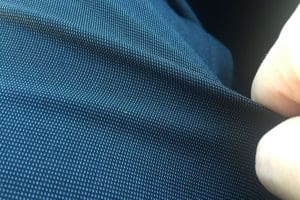I was born with atopic dermatitis and battled with eczema for most of my childhood. Everyone told me I’d grow out of it. Well, this was not the case as I still had the persistent red, inflamed, itchy skin well into my adult years.
What is atopic dermatitis in adults? Atopic dermatitis (AD), also known as atopic eczema, is a type of inflammation of the skin. It’s common in children, but there are many adults suffering from this skin condition. It’s caused by a genetic mutation and/or food allergies. There is no cure, but treatments can relieve itching and prevent new outbreaks.
Read on to learn more about atopic dermatitis in adults, what causes it, and how to treat it.
What is Atopic Dermatitis in Adults?
Atopic dermatitis (AD), sometimes referred to as eczema topic dermatitis is a skin rash that’s particularly common among young children but can last into adulthood. It can also appear in adults who have never experienced it as a child. “Atopic” refers to an allergy, “derm” refers to the skin, and “itis” refers to inflammation.
Atopic dermatitis describes skin inflammation that results from an allergy. More specifically, it happens when the immune system attacks the skin. The skin may break out and become dry and itchy.
The skin may also develop a rash commonly on the flexor surfaces of the body, areas like the creases of the wrists, the insides of the elbows, around the genital region, and the backs of the knees, as well as exposed skin surfaces like on the face, the hands, and the feet.
When the immune system inappropriately starts attacking itself, we call that a hypersensitivity reaction, and there are four types.
Atopic dermatitis, including children and adult atopic dermatitis, is a type 1 hypersensitivity reaction, and it starts off with something in the environment called an allergen, like flower pollen. The pollen is able to travel through the slightly porous skin, where it gets picked up by an immune cell in the tissue just below.
The immune cell is called an antigen-presenting cell because it presents a bit of the allergen to a helper cell, activating it into a Th2 cell. This Th2 cell then stimulates a nearby B cell to start producing IgE or immunoglobulin E antibodies specific to that pollen.
Those IgE antibodies bind to the surface of other immune cells called mast cells, as well as basophils, which can be found in the tissue layer just below the surface of the skin, and this process is called “sensitization.”
Now, let’s say that there’s a second exposure to pollen that makes its way into the skin tissue. The allergen can cross-link the IgE on these sensitized cells, resulting in degranulation or release of a number of pro-inflammatory molecules like histamine, leukotrienes, and proteases.
The combined effect of these molecules is to cause nearby blood vessels to dilate and become leaky as well as attract even more immune cells to the area creating inflammation of the skin tissue.
How to Treat and Get Rid of Atopic Dermatitis in Adults
We’ve looked at what adult atopic dermatitis is, now let’s look at how to treat adult atopic dermatitis. Atopic dermatitis, or dermatitis atopic eczema, is generally a clinical diagnosis, and there are ways to help break the cycle of allergy-mediated inflammation, dry skin, and itching.
With regard to allergy-mediated inflammation, it’s important to identify and avoid any triggers, as well as avoiding overheating, dressing in soft fabrics, and managing stress well, which is, of course, a good life habit anyway.
Dry skin can be managed with frequent moisturization, which is usually best to apply after a lukewarm bath, especially baths with Epsom salt. And itching can sometimes be managed with simple measures like keeping fingernails short and trying to keep yourself from scratching.
But in more extreme cases, there are also topical steroids and calcineurin inhibitors, both of which aim to dampen the immune reaction, as well as antihistamines that can help with itching and antibiotics to help treat skin infections if they are needed.
Other Potential Causes of Atopic Dermatitis In Adults: The Four Horsemen of Eczema
There’s a reason why atopic dermatitis or eczema may be one of the most difficult skin issues to heal. The underlying pathology is likely gut permeability or leaky gut. This is usually the case, except in topical steroid withdrawal – that’s a different topic entirely.
The whole trick of the mat is to heal the gut. Once the gut heals, different types of eczema may also disappear. You can do a lot through diets such as replacing refined sugar with whole fruit like bananas, apples, and oranges.
You can heal the gut incredibly well through diets, but there are four things that can make your life pretty difficult and complicate matters with the gut, and I call them the four horsemen of adult eczema:
- SIBO (Small Intestinal Bacterial Overgrowth)
- Low stomach acid
- Gut flora imbalance
- Parasites
1. SIBO (Small Intestinal Bacterial Overgrowth)
SIBO stands for small intestinal bacterial overgrowth, and this is what happens when bad bacteria that is usually in your large intestine gets into your small intestine.
Your small intestine is supposed to be completely sterile. There’s not supposed to be any bacteria in there but what happens is from years of taking antibiotics or similar offending substances, you can really cause this bacteria to move into the small intestine.
This disrupted small intestine can definitely trigger various types of eczema. SIBO also goes leads to worsening hay fever symptoms. Hay fever is an allergy caused by dust or pollen. If the intestine has a lot of bad bacteria in it, hay fever symptoms will be worse.
2. Low Stomach Acid
Low stomach acid can be a huge problem. A lot of people who take proton pump inhibitors like Prilosec for years can get really bad, low levels of stomach acid. This creates a huge problem when it comes to protein digestion, and that can definitely erode the lining of your gut.
This is purely because we need that stomach acid for proper digestion. If whole big chunks of food are left undigested to rot in your gut, you can be sure that’s gonna cause very big holes to form in the lining.
3. Gut Flora Imbalance
It’s very important that the balance between the good and bad bacteria in your large intestine is always kept in check. If bad bacteria start to overtake the population of good bacteria, you start developing gas.
This gas is the byproduct of little organisms in your intestine. When they eat sugars and other things in your gut, they create gas. This gas causes distension of the gut, and your gut lining actually thins out from this.
4. Parasites
If you get a long tapeworm that’s feeding on your gut lining, you’ll, of course, have a leaky gut. It’s pretty simple, if some people have up to a kilogram of worms inside, lots of small little worms, there’ll be gut issues.
To treat these problems, you need to change your diet and lifestyle. Sometimes cleansing or “detox” is required. Then follow a strict diet for a period of time that excludes certain foods while the gut heals. Afterward, you can reintroduce foods back slowly and assess how your body interacts with them.
The Vicious Itch-Scratch Cycle

Ultimately, the inflammation makes the skin barrier more “leaky,” potentially allowing in more of the allergen while at the same time allowing water to escape, leaving the skin dry and scaly. Dry skin is very itchy (or red itchy), and scratching further damages the skin barrier, worsening the process and setting a vicious cycle of allergy-mediated inflammation, dry skin, skin infections, hay fever, and itching, which characterizes adult atopic dermatitis eczema (or contact dermatitis).
Occasionally, bacteria can invade the damaged skin causing even more inflammation and possibly skin infections. In infants, the rash is most often on the face and scalp, and in children, the rash is usually on flexor surfaces of extremities. Atopic dermatitis or contact dermatitis can worsen in the presence of allergens like cigarette smoke, mold, and dust mites, as well as changes in the weather and even emotional stress. Although it usually causes patches of red itchy skin that come and go, the skin can occasionally even blister and peel. Over time, the skin can be hard and have a texture like leather.
The beginning stages of different types of eczema is called the acute stage, then it moves to the subacute stage, and then the chronic stage. Learn more about the different stages of different types of eczema here: Beginning Stages of Eczema: Causes & Treatments. Also Subacute & Chronic Phase.
Itchiness is often worse at night, perhaps because there are no distractions. This is often when sufferers are most likely to scratch at their eczema lesions. Itchiness is also commonly worse during hay fever season. Hay fever leads to irritating skin and further itching and scratching.
It is critical to do all possible not to scratch the affected areas. A skin allergy from contact dermatitis often only lasts about a couple of weeks. Adult atopic dermatitis eczema flare-ups, however, can last much longer if scratched, from weeks to even months if scratched.
Because adult eczema is an autoimmune-mediated process, it cannot be spread to other people, but since it affects the skin and, therefore, the way a person looks, there is still a lot of social stigmas associated with it. Unfortunately, many individuals, especially teenagers and young adults with atopic dermatitis, suffer from depression and social anxiety as a result.
Genetics plays an important role in atopic dermatitis, and individuals with atopic dermatitis often also have asthma, as well as allergic rhinitis, making up what’s called the atopic triad. These illnesses also often run in families.
Occasionally, atopic dermatitis and contact dermatitis can be part of a syndrome like Hyper IgE syndrome, which has an autosomal dominant form commonly called Job syndrome, phenylketonuria, which is a metabolic disorder that results from a buildup of the amino acid phenylalanine, and Wiskott-Aldrich syndrome, which is an X-linked recessive disease characterized by a clinical triad of eczema, thrombocytopenia, and immunodeficiency. [1].
My Personal Experience with Atopic Dermatitis and My Top Tips for Healing
Atopic dermatitis or eczema has been a part of my life since birth. It has flared up during the colder, winter months, or when there is pollen in the air. My eczema was worse when I was a child, but it gradually got better as I aged.
My top advice for anyone suffering from eczema or atopic dermatitis is to adjust your diet and get plenty of sleep. When it comes to adjusting your diet, I recommend cutting out dairy products and having alternatives instead, such as almond milk or coconut milk. Dairy can trigger and flare up eczema for anyone with atopic dermatitis.
Another diet change I made was to drink more water. I used to drink about 6 glasses a day, but now I drink about double that. By drinking more water, you can help flush away toxins and keep your skin healthy.
Getting enough sleep is another big lesson I have learned in my own personal eczema journey. For anyone with atopic dermatitis, you must get enough sleep. If you don’t get enough sleep, then your skin won’t be able to repair itself. Our skin repairs overnight while asleep. It is a crucial time for the skin to repair and strengthen itself.
When I was in college, I would stay up late to study for exams. I would often get about 4 hours of sleep each night. This was horrible and caused my eczema to get worse.
Another big piece of advice for anyone with atopic dermatitis is to reduce stress in your life. Get out of toxic relationships or toxic situations. When you are stressed, you cannot breathe properly, and your body cannot heal itself properly.
This goes for all ages – young and old. Children and teens can feel immense pressure at school with the burden of getting good grades and getting the perfect score on the test.
You don’t have to stress so much about this. I recommend taking up a calming practice such as yoga or perhaps just walking. Listen to calming music or just be in silence while practicing yoga or walking.
People with atopic dermatitis eczema don’t have to suffer. There are ways to minimize the flare-up and prevent them from occurring. People with atopic dermatitis also can be more aware of their personal health as eczema is a sign that the gut isn’t functioning properly. This can be an early sign that these people need to correct something on the inside so that the skin conditions can improve.
Those people who don’t have atopic dermatitis or eczema and this can actually be a problem for them. They won’t have an early warning signal that something is bad on the inside. I’m sure you know people who can eat all the junk food in the world, and they still have great skin.
This will catch up on them, as there is damage being done on the inside. So to find any positivity in atopic dermatitis, take from it that it gives you an early warning sign to eat healthily, get enough sleep, and exercise.
My last takeaway for anyone suffering from atopic dermatitis is that ‘time heals all.’ You may have horrible skin right now and feel stuck with no improvement in sight. It can take 1, 2, 3, or more years to start seeing any improvement. It took me about 5 years to start to get my eczema under control.
And I now have the habits in place to keep the eczema well-managed. So be patient, as hard as that is. If you do everything correctly, including eat healthily, get enough sleep, and get some movement each day, your skin will gradually improve.
I do recommend that you see a doctor who can diagnose your skin issues and determine how severe your eczema is. The doctor can do an allergy test and even prescribe a temporary steroid cream treatment.
A steroid cream or ointment should only be used temporarily as too much of it can thin out your skin. It can help calm the itch, which will allow you not to scratch the skin and allow the skin to heal.
Conclusion
Atopic dermatitis, also called atopic eczema, is a type 1 hypersensitivity reaction in the skin. It is characterized by a cycle of allergy-mediated inflammation, dry skin, and itching that most commonly affects infants and young children but can transition into adulthood.
It can also appear in adults who had it as a child. Atopic dermatitis can be managed by minimizing exposure to allergens, keeping the skin hydrated, and minimizing itching.
Four other potential causes of adult atopic dermatitis are SIBO (Small Intestinal Bacterial Overgrowth), Low stomach acid, Gut flora imbalance, and Parasites.
To get rid of adult atopic dermatitis, it requires a change in diet and lifestyle. Over time, your gut will heal, and it will then show an improvement in your skin.
Visit your doctor to determine a treatment plan for atopic dermatitis. The treatment plan should include diet, sleep, exercise, medication, skin care routine, and more.
By following the plan consistently, every day, you will see an improvement in your skin and be able to prevent adult atopic dermatitis from flaring up.



